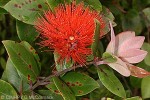Cook Islands Biodiversity Database
Species Page
Metrosideros collina
RataPolynesian Metrosideros
Multimedia & Additional Resources
| Type | Description | Download |
| Flowers and leaves | 69KB |
General Information
Cook Islands Distribution
| Southern Group: Present Makatea: - | ||||||||
RR |
MG |
AT |
MK |
MT |
AK |
PL |
TK |
MN |
++++ |
- |
- |
- |
- |
- |
- |
- |
|
| Northern Group: - | |||||
TN |
MH |
RK |
PK |
NS |
SW |
- |
- |
- |
- |
- |
- |
Scientific Taxonomy
Metrosideros collina (J.R.Forster & G.Forster)
SYNONYMS: Metrosideros collina collina; Metrosideros villosa [sensu TC]
TAXONOMY: PLANTAE; ANTHOPHYTA (=Angiospermae); MAGNOLIOPSIDA (=Dicotyledones); ROSIDAE; Myrtales; MYRTACEAE
More Information
GENERAL NOTE: A widespread and variable genus that has been the subject of much confusion at the species and subspecies level. The Fiji flora of 1985 has three subspecies of Metrosideros collina distributed from Vanuatu to the Societies, while the Hawaiian flora of 1990 lists five endemic species of which one, M. polymorpha has eight subspecies. Genetic analysis of Metrosideros in 2000 cast a new light on the genus. It suggested that the tropical Pacific species arose as a result of at least three separate colonisation events from New Zealand species. It showed that the five species of Hawaii, along with those of Tahiti, Rarotonga and Kermadecs are all nearly identical with NZ's M. excelsa (Pohutukawa); and that they colonised in one or more events in relatively recent times, possibly during the various Ice Ages when strong westerly winds prevailed carrying wind-borne seeds into eastern Polynesia. They also suggested that the M. collina of Vanuatu, Fiji and Samoa had a different and earlier origin than the collina of Eastern Polynesia.
Vouchers & References
Vouchers:
None Recorded.
References:
Special Reference: Wright, S.D. et.al. (2000) Riding the ice age El Nino? Pacific biogeography and evolution of Metrosideros subg. Metrosideros (Myrtaceae) inferred from nuclear ribosomal DNA. Proc. Natl. Acad. Sci. USA 97(8): 4118-4123.
p.964 Wagner et al.- Flowering Plants of Hawaii
p.633 Neal - In Gardens of Hawaii
p.730 Hortus 3rd
p.744 Royal Hort. Soc. Index of Garden Plants
p.685 Tropica
p.3/294 A.C.Smith - Flora Vitiensis Nova
p.279 I Cheeseman - Flora of Rarotonga
p.82 Wilder - Flora of Rarotonga
p.396d Whistler - Ethnobotany of the Cook Islands
p.118 McCormack/Kunzle - Rarotonga's Mountain Tracks and Plants
Data Update History (information):
zTX, zB02, zM03a, zD06a
Web Resources
Citation Information
McCormack, Gerald (2007) Cook Islands Biodiversity Database, Version 2007.2. Cook Islands Natural Heritage Trust, Rarotonga. Online at http://cookislands.bishopmuseum.org. ![]()
Please refer to our use policy.

